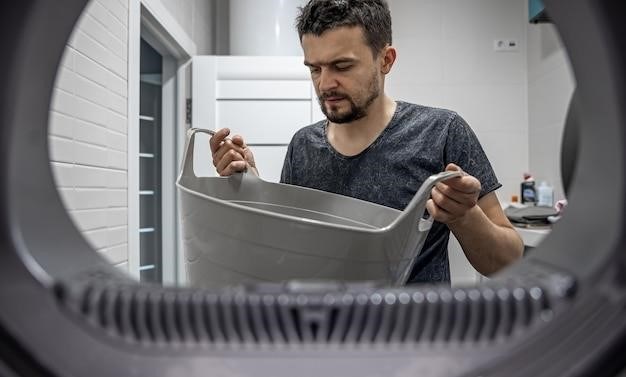This guide provides comprehensive troubleshooting for Bosch washing machines. Learn to identify common problems, understand error codes, and fix issues like starting problems, draining issues, leaks, spinning problems, and more. Maintain your machine and know when to seek professional help. We offer detailed guides, repair tips, and maintenance advice.
Identifying Common Problems
Before diving into specific repairs, systematically identify the issue with your Bosch washing machine. Start by observing the machine’s behavior⁚ Does it power on? Does water enter? Does the drum rotate? Does it drain properly? Note any unusual sounds like grinding, squealing, or banging. These clues indicate the potential source of the problem. Check the display panel for error codes; these often pinpoint malfunctions. Inspect the water supply hoses for kinks or leaks. Examine the drain hose for blockages or improper connections. Ensure the machine is level and not overloaded with laundry; A simple visual check often reveals the root cause, saving time and effort in more complex troubleshooting steps. If the problem persists after these initial checks, consult a more detailed troubleshooting guide or seek professional assistance.
Common problems include the machine not starting, failure to drain, leaking water, inconsistent spinning, noisy operation, and clothes not being thoroughly cleaned. These problems can stem from various sources, such as faulty components, incorrect installation, or even simple user errors. Careful observation and systematic checking can quickly lead you to the correct diagnosis. Remember to always disconnect the power supply before attempting any internal inspections or repairs.

Understanding Error Codes
Bosch washing machines utilize error codes displayed on their control panels to signal specific malfunctions. These codes are crucial for efficient troubleshooting. Each code corresponds to a particular problem, allowing for targeted solutions. Refer to your machine’s user manual for a comprehensive list of error codes and their meanings. The manual typically provides detailed explanations and suggested troubleshooting steps for each code. If the manual is unavailable, searching online for your specific model number and error code can yield valuable information from Bosch support websites, forums, and repair communities. Understanding error codes can significantly reduce repair time and costs. For example, an E17 code often points to a water level issue, while an F21 code might indicate a problem with the motor or spin cycle. Knowing the specific problem highlighted by the error code allows you to focus your efforts on the relevant components and avoid unnecessary checks.
However, error codes are not always foolproof. Sometimes, multiple issues can trigger the same code, or a fault may not be accurately reflected in the code. Always combine error code analysis with a thorough visual inspection of your machine. If you’re unsure about interpreting the code or resolving the problem, contacting a qualified repair technician is advisable to prevent further damage to the appliance.
Troubleshooting Washing Machine Not Starting
If your Bosch washing machine refuses to start, systematic troubleshooting is key. Begin by ensuring the machine is properly plugged into a functioning power outlet. Check the circuit breaker or fuse box to rule out a tripped breaker or blown fuse. A simple power cycle—unplug the machine for a few minutes, then plug it back in—can sometimes resolve minor electrical glitches. Next, examine the door latch mechanism. Ensure the door is securely closed; a faulty latch can prevent the machine from starting. Inspect the door switch; if it’s malfunctioning, the machine won’t initiate a cycle. Carefully check for any obstructions preventing the door from closing completely, like clothing caught in the seal.
Next, verify that the water supply valves are fully open and that water pressure is adequate. Low water pressure can prevent the machine from starting, as it needs sufficient water to initiate a wash cycle. Check the inlet hoses for kinks or blockages that might restrict water flow. Examine the control panel; ensure the selected wash cycle is appropriate and that the start button has been pressed correctly. If the issue persists, consult your user manual for model-specific troubleshooting advice or error codes. If all else fails, contacting a qualified technician may be necessary to diagnose more complex electrical or mechanical problems.
Diagnosing and Fixing Draining Issues
A Bosch washing machine failing to drain properly can stem from several causes. First, check the drain hose for kinks, clogs, or blockages. Ensure the hose isn’t crimped or twisted, and that it’s positioned correctly, allowing for smooth water flow. A clogged drain hose can significantly impede drainage. The drain pump filter, located at the bottom of the machine, is another common culprit. Access the filter (consult your manual for instructions) and carefully remove any lint, debris, or foreign objects that may be obstructing its operation. Clean the filter thoroughly, ensuring all accumulated residue is removed. Sometimes, a simple blockage in the pump is the issue.
Inspect the drain pipe connection for any blockages or restrictions. A partially clogged drain pipe can prevent the machine from draining effectively. If the problem persists after checking the hose, filter, and drain pipe, the drain pump itself might be faulty. A malfunctioning drain pump will prevent the machine from draining, and may require professional repair or replacement. Before calling a technician, try running a drain cycle multiple times. Sometimes, persistent clogs or minor blockages can be cleared by repeated draining attempts. If you’re uncomfortable working with internal components, always seek expert assistance to avoid causing further damage to your appliance.
Addressing Leaking Problems
Leaks in a Bosch washing machine can originate from various points. Begin by visually inspecting the water supply hoses for any cracks, splits, or loose connections. Tighten any loose connections, and replace any damaged hoses immediately to prevent further leaks and potential water damage. A faulty inlet valve can also cause leaks. These valves control the water flow into the machine. If a valve is malfunctioning, it may leak water even when the machine isn’t running. Testing the valves may require specialized tools and knowledge, and professional assistance might be necessary for diagnosis and repair. Examine the door seal carefully. Over time, the seal can wear down, crack, or become damaged, leading to leaks.
Check for any visible damage or wear and tear. A damaged door seal needs replacement to effectively prevent leaks. The drain hose is another potential source of leaks. Ensure it’s securely connected to both the washing machine and the drainpipe, and that there are no cracks or holes in the hose itself. If the leak persists despite checking these areas, the problem could lie within the machine’s internal components, such as a faulty pump or a damaged tub. In such cases, seeking professional assistance is crucial to avoid further damage and ensure a safe and effective repair. Remember to always disconnect the power supply before attempting any maintenance or repair work.
Solving Spinning Problems
If your Bosch washing machine isn’t spinning properly, several factors could be at play. An unbalanced load is a common culprit. Ensure clothes are evenly distributed inside the drum to prevent the machine from detecting an imbalance and halting the spin cycle. Overloading the machine can also lead to spinning problems. Check the machine’s capacity and avoid exceeding it. A faulty spin motor is another possibility. The motor is responsible for rotating the drum during the spin cycle. If it malfunctions, the drum may not spin at all or may spin erratically. Diagnosing a motor problem may require testing with specialized tools, often necessitating professional intervention. Inspect the drive belt, a component connecting the motor to the drum. A worn, broken, or loose drive belt can prevent the drum from spinning correctly. A simple visual inspection can reveal obvious signs of wear and tear. Replacement might be necessary if damage is present.
The drum’s bearings are crucial for smooth spinning. Worn-out bearings can cause noise, vibration, and ultimately, spinning failure. Detecting bearing wear may require professional expertise, as it often involves disassembling parts of the machine. Examine the suspension system, responsible for supporting the drum and dampening vibrations. Damaged or worn-out suspension components can hinder proper spinning. If the problem persists after checking these elements, consider contacting a qualified technician. They possess the knowledge and tools to diagnose and address more complex internal issues.

Maintaining Your Bosch Washing Machine
Regular maintenance significantly extends the lifespan of your Bosch washing machine and prevents costly repairs. Begin by cleaning the detergent dispenser regularly. Detergent residue can build up, hindering proper dispensing and potentially causing clogs. Remove the dispenser drawer, wash it thoroughly with warm, soapy water, and rinse it completely before reinstalling. Clean the lint filter after each wash cycle. The filter traps lint and debris, preventing them from clogging the drainage system. Locate the filter, usually at the bottom front of the machine, open it carefully, and remove any accumulated lint. Periodically inspect and clean the drain pump filter. This filter catches larger debris that may not be caught by the lint filter. Access to the pump filter varies depending on the model; consult your user manual for specific instructions. Inspect the door seal for any signs of wear or tear. A damaged seal can lead to leaks and reduce the machine’s efficiency. Check for any mold or mildew growth and clean it immediately using a mild bleach solution.
Avoid overloading the machine. Overloading puts unnecessary strain on the motor and other components, potentially leading to premature wear and tear. Adhere to the manufacturer’s recommended load capacity. Use the appropriate amount of detergent. Excessive detergent can lead to residue buildup, while insufficient detergent may result in less-than-optimal cleaning. Always refer to your washing machine’s user manual for specific maintenance recommendations and cleaning instructions. Regular maintenance ensures optimal performance and prolongs the life of your valuable appliance.
Seeking Professional Help
Despite diligent troubleshooting, some Bosch washing machine problems require professional expertise. Persistent error codes that you can’t resolve despite consulting the manual indicate a more complex issue needing a qualified technician’s attention. Unusual noises, like loud banging or grinding during operation, suggest potential mechanical problems within the machine’s internal components. These could be related to the motor, bearings, or other intricate parts best handled by a trained professional. Recurring leaks, even after checking hoses and seals, warrant immediate professional attention to prevent water damage to your property. If the machine completely fails to start or power on, and you’ve ruled out simple issues like power supply or circuit breaker problems, professional assistance is necessary. Similarly, a washing machine that consistently fails to drain or spin properly, despite cleaning filters and checking drainage, should be inspected by a qualified repair person; Don’t attempt advanced repairs yourself unless you possess the necessary technical skills and experience. Incorrect repairs can worsen the problem and potentially void your warranty. Contact Bosch customer support or a reputable appliance repair service for assistance. They possess the tools, knowledge, and parts to diagnose and repair complex problems efficiently and safely.
